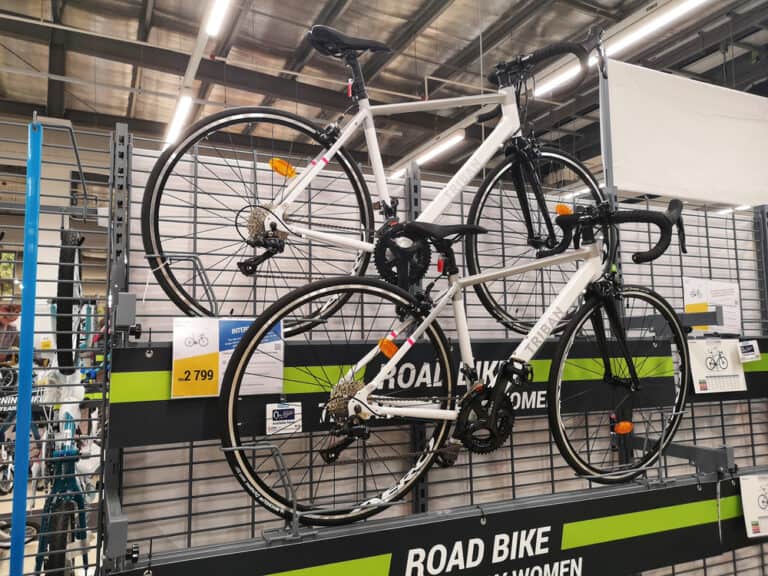How Far Can You Lean A Road Bike?

Without leaning a bike into a corner, a road bike and the rider will continue on a straight line with devastating results. By sub-consciously counter-steering when entering a corner, we lean the bike to counter the increasing centripetal force pushing the bike outwards. How far can you lean a road bike?
The appearance of the surface plays a big part in how far you can lean on a road bike. For good pavement with no water, oil, or slick spots, the lean angle is roughly 45°. A crowned road without any banking with a surface fall of 10° will allow up to 35°. A curved bank allows 55° at the vertical of the corner.
When leaning into a corner on a road bike, many internal and external forces are at play. Coupled with mass distribution, the forward speed of the bike, and traction control, it becomes a bit of a science. Most experts agree that you can safely lean a road bike at a 45° angle, a little more in certain scenarios.
How Far Can You Lean A Road Bike?
Bicycles, and the science behind how they move, have led to a monstrous body of work regarding exactly why a bicycle can move and function as it does. Famous 18th-century scientist Rankine asserted that to maintain the balance of a bike, you needed to steer it in the direction of the lean.
Technically, you can lean a road bike until the inside pedal makes contact with the ground, which is dangerous and not ideal, or until your wheels lose their grip on the road resulting in a sliding crash. As a rider, none of these scenarios are inviting.
Riding a bike is a pretty involved science, as there are more than 20+ different parametric quantities when describing all of a bike’s motion, and the books and studies written on the subject will fill a couple of libraries.
Many forces are at play when you lean and steer a road bike. Forces such as gravity, the centripetal force, the ratio of the force of friction between the tire and the tarmac and the force applied to them, the center of mass distribution, and gyroscopic precession are but a few.
Let us turn our attention to icons of the bicycle world and see what they have to say about how far you can lean on a road bike. Bicycle legend Jobst Brand, author of “The Bicycle Wheel,” knew a few things about bike aerodynamics, having worked for Stanford Linear Accelerator Center and Avocet.
In an article titled “Descending,” Brand describes to the reader that the angle with the road surface is the most important factor when estimating the lean angle required when cornering with a road bike. The “how far can you lean a road bike” question comes down to the type of road surface.
Jobst mentions that “lean angle is limited by the available traction that must be assessed from velocity and appearance of the surface.” He also mentions that “for good pavement, this angle is about 45°, in the absence of oil, water, or smooth and slick spots.”
Brand declares that a “curve banked inward 10° allows a lean of up to at least 55° from the vertical” and that “a crowned road with no banking, where the surface falls off about 10°, would only allow up to 35°.
Jim Papadopoulos, a senior engineer and contributor to “Bicycling Science,” mentions that trail plays a part in the maximum lean angle of a road bike.
A bike’s trail can be described as the unseen line that extends down the bike’s steerer tube to the surface. The trail is the distance by which the front wheel’s contact points trail behind the ground contact point of the steering axis.
When the line is in front of the wheel’s contact point with the surface, it is described as a “positive trail,” which is more stable than a “negative trail.” Traditional bikes are designed with the positive trail in mind and steer the front wheel in the lean direction.
Papadopoulos believes that most cyclists ride with a “positive trail” where a 45° lean is not exceeded, except when a turn has a radius of 5m or greater, whereby traction becomes more of an issue than the trail.
Factors That Affect How Far You Can Lean A Road Bike
How far can I lean my road bike question is difficult. Under certain circumstances, you can lean the road bike at 45° without any problems, or even 55° in some instances, but a specific lean angle will not work under certain conditions.
Lean and steering go hand in hand, but if the conditions are not perfect, a too drastic lean might very well be why you and your bike take a slide under the following conditions. Here are some factors that affect how far you can lean a road bike:
The Coefficient Of Friction Is Key To How Far You Can Lean
Never underestimate the required friction that needs to be present between the road and your bike’s tires when leaning and steering.
The coefficient of friction can be described as the ratio of the frictional force, which is resisting the motion of two interacting surfaces combined with the normal force pushing the surfaces together.
The coefficient of friction can be affected when normal force decreases due to a change in the road surface. A depression in the road, riding over a drain cover, cornering over loose gravel, or riding over the ever-dangerous white line (especially when wet), can lead to a wheel slip, no matter how far or how little you lean.
When the coefficient of friction is exceeded, it can also result in a meeting with the tarmac. When the frictional force is exceeded, typically due to a too-tight cornering line, your lean angle will be affected negatively and can result in your tire slipping.
The Corner Angle
The radius of a corner directly influences the amount of bike lean. A wide turn results in less bike lean, and a tight turn requires more. The cornering angle is almost always greater than the required balancing angle.
It’s always safer to lean your bike more than you lean your body, as keeping your center of mass over the middle and forward part of the bike will result in less lateral movement of the front wheel, thereby creating more downforce on the wheel. The more downforce on the wheel, the better the cornering bite.
The Condition Of The Road
Wet roads, iced roads, gravel roads, and the famous “asphalt flea market” (a stretch of road littered with glass, tins, and other in-the-way debris will automatically force you to assess conditions before leaning into a corner) is examples of extreme road conditions.
When dangerous road conditions are around the bend, it may be too late, and damage control will be required, either by decreasing your lean or by reducing your speed by expertly using your brakes.
Chip seal roads, commonly referred to as the “sandpaper circuit,” are pavement that’s been treated with a thin layer of liquid asphalt and layers of fine aggregate that results in a harsh finish which can be described as a zillion sharp-edged embedded and loose rocks.
Chip seal roads usually involve many bumps and potholes, hence the treatment to extend the road’s life. Be careful when riding on one, as road bike tires are not very sturdy on these types of roads, especially when you lean excessively into a corner.
Should you find some concrete corners on your ride, be wary of exposed aggregate, which can feel as if you’re riding over rocky sandpaper and is not road bike lean-friendly.
Your Bike Setup Can Affect The Amount Of Lean
The dynamics of your bike play a role in the amount of “safe” lean you can perform on it on different corner setups. The factors that will restrict the amount of lean are the following:
Long cranks, paired with a low-centered bottom bracket, will result in a decrease in lean potential.

5 Steps To Help You Lean And Corner With More Confidence
A non-biker, or a novice, when looking at a standard road bike, may think that it’s a pretty dangerous piece of equipment to risk your life on. Small tires, narrow handlebars, and a lightweight frame that has trouble staying on the road when the wind picks up don’t install confidence in most.
Many might pass the opportunity to climb on one and experience the thrill a road bike ultimately gives a rider. If you’re new to riding road bikes and not as confident in taking corners as you would like, then the following basic steps are for you.
Step 1: Focus On The Road Where You Want To Go
Rule number one is an important one. When cornering (before, during, and after), you must focus on the spot where you want you and the bike to go, meaning the spot in the road you’re aiming to ride on through.
What you don’t want to do is to focus on other elements typically found in and around corners, lamp posts, road signs, trees, and boulders. When riding a bike, there’s a thing called target fixation.
Target fixation is when you focus on something, and even if you don’t want to go near the point of your focus, you are drawn to it, especially in corners. Don’t want to hit the tree? Don’t look at it. Rather look at the next part of the road you want to pass through, the next, and so on.
Step 2: Resist Braking In The Corner
Braking is a critical element in cornering. Braking before the center of the corner and creating the correct corner speed before leaning into one is the safe way to approach one. If the corner is tight, you need to go slow, as going into a corner at too great a speed is dangerous.
Hitting the brakes while you are in the corner, especially while leaning into the corner, can result in a wipe or slide out.
Adding deceleration to the tires, which are under massive lateral load already, isn’t advised unless it’s done to avoid an accident. Use the rear brake only if you must apply brakes in a corner.
Braking should be done when the road bike travels in a straight line before slowly releasing the brakes before the center of the corner.
Step 3: Drop The Outside Pedal To The 6 O’Clock Position
Before you lean into a corner, you should look at the spot where you want to go and be done with breaking to the correct speed you’re comfortable with. The last thing before leaning into the corner is to get your pedals in the correct position.
The leg on the outside of the corner needs to be in the 6 o’clock position, and you need to push your weight through it.
The principle is that it helps keep your weight over the tires and your mass centered and also ensures that the inside pedal is at the 12 o’clock position, which results in maximum ground clearance while leaning into a corner.
Step 4: Lean Into The Corner
The most important part of cornering is when you lean your bike into the corner. When leaning your bike, your center of balance needs to be further over to the inside than the contact point with your tires and the tarmac.
Ensure that your weight and balance are forward and not upright. The idea is to shift more weight to the front contact patch as traction is helped by weight. Keep your center of gravity low and to the outside.
Use your inside hand to put pressure on the bike’s handlebars to create a counterbalance that helps to keep the tires in firm contact with the road.
Leaning might feel awkward at first, and you might feel that you don’t trust the process with the thin tires and such, and that’s normal. You need to trust the process, and by practicing leaning your bike, you will quickly grow in confidence.
How far you lean your bike is up to you. Should you see your inside pedal sparking, then it’s too far. Be careful and mindful of road conditions that can cause problems with grip should you lean too aggressively; these include wet roads, sand, mud, drain covers, and painted lines.
Step 5: Practice Makes Leaning And Cornering Fun
Many opposing forces are at play when cornering a road bike, and leaning into one is scary at first, especially at high speeds. The more you practice the basics mentioned above, the more confident and, most importantly, comfortable you will become while cornering.
Never lean more than 40° in the beginning, as it’s no fun hitting the tarmac. Envision your bike and your body on one plane. The bike can lean more than the body, but your body should never lean more than the bike.
Luckily, as with most things, you will quickly find your groove and cornering style the more you practice.
Conclusion
How far you can lean into a corner is difficult to answer as so many variables, forces, and conditions affect the lean angle. It’s a science, and many engineers and scientists are still, to this day, exploring the mechanics of why a bike moves and behaves as it does.
With each corner being different, the best advice is to find your ideal lean angle, which you only get to know by trial and error. A 45° maximum lean angle is safe when conditions are favorable.
References
- https://www.sheldonbrown.com/brandt/descending.html
- https://www.explainthatstuff.com/bicycles.html
- https://ocw.mit.edu/courses/es-010-chemistry-of-sports-spring-2013/359e8791459643970a1c4bdbd563f465_MITES_010S13_lec6.pdf
- https://forum.bikeradar.com/discussion/13069887/how-far-can-you-lean-your-bike-over-in-a-bend
- https://www.quora.com/How-far-can-you-lean-a-road-bike
- http://ruina.tam.cornell.edu/research/topics/bicycle_mechanics/Pap&Olson88biketech.pdf
- https://physics.stackexchange.com/questions/335716/difference-between-motorcycle-and-road-bike-max-lean-angle
- https://www.stevemunden.com/leanangle.html
- https://www.scientificamerican.com/article/the-bicycle-problem-that-nearly-broke-mathematics/
- https://www.slowtwitch.com/Tech/The_Physics_of_Moving_a_Bike_163.html
- https://www.dirtandgravel.psu.edu/sites/default/files/General%20Resources/Technical%20Bulletins/TB_Crown_and_Cross_Slope.pdf
- https://study.com/learn/lesson/coefficient-of-friction.html






